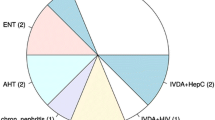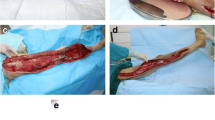Abstract
Purpose
Necrotizing fasciitis (NF) is a rapidly progressive inflammatory infection of the fascia, with secondary necrosis of the subcutaneous tissues. The severity of the disease depends on the virulence of the organism and host immunity. There is a paucity of reports on the prevalence of NF causing pathogens and management.
Methods
Retrospective data of patients treated for NF were collected from two tertiary care hospitals in Central Malaysia between January 2014 and December 2018.
Results
A total of 469 NF patients were identified. More than half of the NF patients were males (n = 278; 59.28%). The highest number of cases was found among age groups between 30 and 79, with mean age of 56.17. The majority of the NF cases (n = 402; 85.72%) were monomicrobial. Streptococcus spp. (n = 89; 18.98%), Pseudomonas aeruginosa (n = 63; 13.44%) and Staphylococcus spp. (n = 61; 13.01%) were identified as the top three microorganisms isolated. Among the 469 NF cases, 173 (36.8%) were amputated or dead while 296 (63.1%) recovered. Proteus spp. (n = 19; 12.93%), Klebsiella pneumoniae (n = 18; 12.24%) and Escherichia coli (n = 14; 9.52%) were associated with all types of amputations. The most common antibiotic prescribed was unasyn (n = 284; 60.56%), followed by clindamycin (n = 56; 11.94%) and ceftazidime (n = 41; 8.74%). A total of 239 (61.8%) recovered while 148 (38.2%) were either amputated or dead when managed with the unasyn, clindamycin or ceftazidime.
Conclusion
This study represents the largest NF cases series in Malaysia highlighting the causative agents and management.
Similar content being viewed by others
References
Kihiczak GG, Schwartz RA, Kapila R (2006) Necrotizing fasciitis: A deadly infection. J Eur Acad Dermatology Venereol. https://doi.org/10.1111/j.1468-3083.2006.01487.x
Salcido RS (2007) Necrotizing fasciitis: reviewing the causes and treatment strategies. Adv Skin Wound Care. https://doi.org/10.1097/01.ASW.0000269317.76380.3b
Hakkarainen TW, Kopari NM, Pham TN, Evans HL (2014) Necrotizing soft tissue infections: Review and current concepts in treatment, systems of care, and outcomes. Curr Probl Surg. https://doi.org/10.1067/j.cpsurg.2014.06.001
Misiakos EP, Bagias G, Patapis P, Sotiropoulos D, Kanavidis P, Machairas A (2014) Current concepts in the management of necrotizing fasciitis. Front Surg. https://doi.org/10.3389/fsurg.2014.00036
Morgan MS (2010) Diagnosis and management of necrotising fasciitis: A multiparametric approach. J Hosp Infect. https://doi.org/10.1016/j.jhin.2010.01.028
Stevens DL, Bryant AE (2017) Necrotizing soft-tissue infections. N Engl J Med. https://doi.org/10.1056/NEJMra1600673
Lancerotto L, Tocco I, Salmaso R, Vindigni V, Bassetto F (2012) Necrotizing fasciitis: Classification, diagnosis, and management. J Trauma Acute Care Surg. https://doi.org/10.1097/TA.0b013e318232a6b3
Devaney B, Frawley G, Frawley L, Pilcher DV (2015) Necrotising soft tissue infections: The effect of hyperbaric oxygen on mortality. Anaesth Intensive Care. https://doi.org/10.1177/0310057x1504300604
Naseer U, Steinbakk M, Blystad H, Caugant DA (2016) Epidemiology of invasive group A streptococcal infections in Norway 2010–2014: A retrospective cohort study. Eur J Clin Microbiol Infect Dis. https://doi.org/10.1007/s10096-016-2704-y
Bocking N, Matsumoto C, Loewen K et al (December 2016) High incidence of invasive group a streptococcal infections in remote indigenous communities in Northwestern Ontario, Canada. Open Forum Infect Dis:ofw243. https://doi.org/10.1093/ofid/ofw243
Schröder A, Gerin A, Firth GB, Hoffmann KS, Grieve A, Oetzmann von Sochaczewski C (2019) A systematic review of necrotising fasciitis in children from its first description in 1930 to 2018. BMC Infect Dis 19(1):317. https://doi.org/10.1186/s12879-019-3941-3
Khamnuan P, Chongruksut W, Jearwattanakanok K, Patumanond J, Tantraworasin A (2015) Necrotizing fasciitis: Epidemiology and clinical predictors for amputation. Int J Gen Med. https://doi.org/10.2147/IJGM.S82999
Bilton BD, Zibari GB, McMillan RW, Aultman DF, Dunn G, McDonald JC (1998) Aggressive surgical management of necrotizing fasciitis serves to decrease mortality: A retrospective study. Am Surg.
Anaya DA, McMahon K, Nathens AB, Sullivan SR, Foy H, Bulger E (2005) Predictors of mortality and limb loss in necrotizing soft tissue infections. Arch Surg. https://doi.org/10.1001/archsurg.140.2.151
Obayashi L, Konstantinidis A, Shackelford S et al (2011) Necrotizing soft tissue infections: Delayed surgical treatment is associated with increased number of surgical debridements and morbidity. J Trauma - Inj Infect Crit Care. https://doi.org/10.1097/TA.0b013e31820db8fd
Iacopi E, Coppelli A, Goretti C, Piaggesi A (2015) Necrotizing fasciitis and the diabetic foot. Int J Low Extrem Wounds. https://doi.org/10.1177/1534734615606534
Stevens DL, Bisno AL, Chambers HF et al (2014) Practice guidelines for the diagnosis and management of skin and soft tissue infections: 2014 update by the infectious diseases society of America. Clin Infect Dis. https://doi.org/10.1093/cid/ciu296
Giuliano A, Lewis F, Hadley K, Blaisdell FW (1977) Bacteriology of necrotizing fasciitis. Am J Surg. https://doi.org/10.1016/0002-9610(77)90283-5
Madsen MB, Skrede S, Perner A et al (2019) Patient’s characteristics and outcomes in necrotising soft-tissue infections: results from a Scandinavian, multicentre, prospective cohort study. Intensive Care Med. https://doi.org/10.1007/s00134-019-05730-x
Rodriguez C, Jary A, Hua C et al (2019) Pathogen identification by shotgun metagenomics of patients with necrotizing soft-tissue infections. Br J Dermatol. https://doi.org/10.1111/bjd.18611
Tunovic E, Gawaziuk J, Bzura T, Embil J, Esmail A, Logsetty S (2012) Necrotizing fasciitis: A six-year experience. J Burn Care Res. https://doi.org/10.1097/BCR.0b013e318239d571
Nawijn F, Verhiel SHWL, Lunn KN, Eberlin KR, Hietbrink F, Chen NC (2020) Factors associated with mortality and amputation caused by necrotizing soft tissue infections of the upper extremity: A retrospective cohort study. World J Surg. https://doi.org/10.1007/s00268-019-05256-9
Chang CP, Hsiao CT, Lin CN, Fann WC (2018) Risk factors for mortality in the late amputation of necrotizing fasciitis: A retrospective study. World J Emerg Surg. https://doi.org/10.1186/s13017-018-0207-0
Bair MJ, Chi H, Wang WS, Hsiao YC, Chiang RA, Chang KY (2009) Necrotizing fasciitis in southeast Taiwan: clinical features, microbiology, and prognosis. Int J Infect Dis. https://doi.org/10.1016/j.ijid.2008.04.015
Dworkin MS, Westercamp MD, Park L, McIntyre A (2009) The epidemiology of necrotizing fasciitis including factors associated with death and amputation. Epidemiol Infect. https://doi.org/10.1017/S0950268809002532
Gemmell CG, Peterson PK, Schmeling D et al (1981) Potentiation of opsonization and phagocytosis of streptococcus pyogenes following growth in the presence of clindamycin. J Clin Invest. 67(5):1249–1256. https://doi.org/10.1172/JCI110152
Stevens DL, Bryant AE, Yan S (1994) Invasive group A streptococcal infection: New concepts in antibiotic treatment. Int J Antimicrob Agents. https://doi.org/10.1016/0924-8579(94)90029-9
Drake DB, Woods JA, Bill TJ et al (1998) Magnetic resonance imaging in the early diagnosis of group a β streptococcal necrotizing fasciitis: A case report. J Emerg Med. https://doi.org/10.1016/S0736-4679(98)00013-4
Stevens DL, Bryant AE, Hackett SP (1995) Antibiotic effects on bacterial viability, toxin production, and host response. Clin Infect Dis. https://doi.org/10.1093/clinids/20.Supplement_2.S154
Ahmed S, Ali SR, Samani ZA (2012) Pseudomonas Necrotizing Fasciitis in an Otherwise Healthy Infant. Case Rep Infect Dis. https://doi.org/10.1155/2012/517135
Hietbrink F, Bode LG, Riddez L, Leenen LPH, van Dijk MR (2016) Triple diagnostics for early detection of ambivalent necrotizing fasciitis. World J Emerg Surg. https://doi.org/10.1186/s13017-016-0108-z
Chen Y, Wang X, Lin G, Xiao R (2018) Successful treatment following early recognition of a case of Fournier’s scrotal gangrene after a perianal abscess debridement: A case report. J Med Case Rep. https://doi.org/10.1186/s13256-018-1697-9
D’Arena G, Pietrantuono G, Buccino E, Pacifico G, Musto P (2013) Fournier’s gangrene complicating hematologic malignancies: A case report and review of licterature. Mediterr J Hematol Infect Dis. https://doi.org/10.4084/MJHID.2013.067
Kuzaka B, Wróblewska MM, Borkowski T et al (2018) Fournier’s Gangrene: Clinical presentation of 13 cases. Med Sci Monit. https://doi.org/10.12659/MSM.905836
Eckmann C, Heizmann W, Bodmann KF, Von Eiff C, Petrik C, Loeschmann PA (2015) Tigecycline in the treatment of patients with necrotizing skin and soft tissue infections due to multiresistant bacteria. Surg Infect (Larchmt). https://doi.org/10.1089/sur.2014.089
Zanetti S, Spanu T, Deriu A, Romano L, Sechi LA, Fadda G (2001) In vitro susceptibility of Vibrio spp. isolated from the environment. Int J Antimicrob Agents. https://doi.org/10.1016/S0924-8579(01)00307-7
Acknowledgements
We would like to acknowledge our gratitude to the Head of Department of Orthopaedics, Hospital Tuanku Jaafar Seremban and Hospital Ampang for their cooperation and support in this study.
Author information
Authors and Affiliations
Contributions
Conceptualization, SR and VKN; methodology, SR and VKN; software, LPY; validation, SR and VKN; formal analysis, LPY; investigation, RR, TEK, MAHAH, ZS, SSSS.; resources, RR, TEK, MAHAH, ZS, SSSS; data curation, LPY; writing—original draft preparation, SM, RN, VKN and SR; writing—review and editing, SM, RR, VKN and SR.; visualization, SR and VKN; supervision, SR; project administration. All authors have read and agreed to the published version of the manuscript.
Corresponding author
Ethics declarations
Conflict of interest
The authors declare that they have no conflict of interest.
Consent to participate
This is a retrospective study; hence, no consent was obtained from subjects; however, the study was conducted after approval from the ethics committee.
Additional information
Publisher’s note
Springer Nature remains neutral with regard to jurisdictional claims in published maps and institutional affiliations.
Rights and permissions
About this article
Cite this article
Rampal, S., Maniam, S., Lim, P.Y. et al. Necrotizing fasciitis, causative agents and management: a five-year retrospective study in two tertiary care hospitals in Central Malaysia. International Orthopaedics (SICOT) 45, 1399–1405 (2021). https://doi.org/10.1007/s00264-020-04905-2
Received:
Accepted:
Published:
Issue Date:
DOI: https://doi.org/10.1007/s00264-020-04905-2




